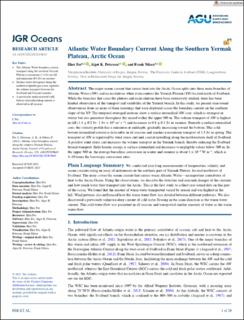| dc.contributor.author | Fer, Ilker | |
| dc.contributor.author | Peterson, Algot Kristoffer | |
| dc.contributor.author | Nilsen, Frank | |
| dc.date.accessioned | 2023-09-14T11:23:54Z | |
| dc.date.available | 2023-09-14T11:23:54Z | |
| dc.date.created | 2023-09-01T10:24:24Z | |
| dc.date.issued | 2023 | |
| dc.identifier.issn | 0148-0227 | |
| dc.identifier.uri | https://hdl.handle.net/11250/3089441 | |
| dc.description.abstract | The major ocean current that carries heat into the Arctic Ocean splits into three main branches of Atlantic Water (AW) and recirculations when it encounters the Yermak Plateau (YP) located north of Svalbard. While the branches that cross the plateau and recirculations have been extensively studied, there has been limited observation of the transport and variability of the Yermak branch. In this study, we present year-round observations from an array of three moorings that were deployed across the boundary current on the southern slope of the YP. The temporal-averaged sections show a surface-intensified AW core, which is strongest in winter but also persistent throughout the record within the upper 500 m. The volume transport of AW is highest in fall (1.4 ± 0.2 Sv; 1 Sv = 106 m3 s−1) and decreases to 0.8 ± 0.1 Sv in summer. Beneath a surface-intensified core, the velocity profile has a minimum at middepth, gradually increasing toward the bottom. This cold, bottom-intensified current is detectable in all seasons and reaches a maximum transport of 1.5 Sv in spring. The transport of AW is regulated by wind stress curl and coastal upwelling along the northwestern shelf of Svalbard. A positive wind stress curl increases the volume transport in the Yermak branch, thereby reducing the Svalbard branch transport. Eddy kinetic energy is surface-intensified and decreases to negligible values below 500 m. In the upper 500 m, the average baroclinic conversion in winter and summer is about 1 × 10−5 W m−3, which is 4–10 times the barotropic conversion rates. | en_US |
| dc.language.iso | eng | en_US |
| dc.publisher | AGU | en_US |
| dc.relation.uri | https://agupubs.onlinelibrary.wiley.com/doi/10.1029/2023JC019645 | |
| dc.rights | Navngivelse 4.0 Internasjonal | * |
| dc.rights.uri | http://creativecommons.org/licenses/by/4.0/deed.no | * |
| dc.title | Atlantic Water Boundary Current Along the Southern Yermak Plateau, Arctic Ocean | en_US |
| dc.type | Journal article | en_US |
| dc.type | Peer reviewed | en_US |
| dc.description.version | publishedVersion | en_US |
| dc.rights.holder | Copyright 2023 The Author(s) | en_US |
| dc.source.articlenumber | e2023JC019645 | en_US |
| cristin.ispublished | true | |
| cristin.fulltext | original | |
| cristin.qualitycode | 1 | |
| dc.identifier.doi | https://doi.org/10.1029/2023JC019645 | |
| dc.identifier.cristin | 2171564 | |
| dc.source.journal | Journal of Geophysical Research (JGR): Oceans | en_US |
| dc.relation.project | Norges forskningsråd: 276730 | en_US |
| dc.relation.project | Norges forskningsråd: 229786 | en_US |
| dc.subject.nsi | VDP::Oseanografi: 452 | en_US |
| dc.subject.nsi | VDP::Oceanography: 452 | en_US |
| dc.identifier.citation | Journal of Geophysical Research (JGR): Oceans. 2023, 128 (6), e2023JC019645. | en_US |
| dc.source.volume | 128 | en_US |
| dc.source.issue | 6 | en_US |

